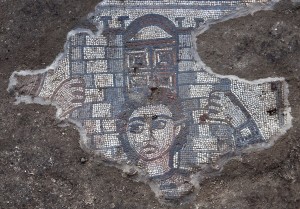A BYU professor and a recent BYU graduate helped uncover a unique pair of mosaics at a synagogue excavation in Galilee.
The mosaics decorate the floor of a fifth-century synagogue in the ancient village of Huqoq in Israel’s Lower Galilee. One of these mosaics depicts Samson carrying the gates of Gaza, and it comes one year after a separate Samson mosaic was uncovered at the same location.
Assistant professor Mathew Grey from the department of ancient scripture, who supervised the excavation of the synagogue area, explained that these discoveries are changing the way scholars think about ancient Jewish art and synagogue worship.
“This is helping us to better understand which stories from the Bible were catching their attention and which stories they were incorporating into their synagogue worship,” Grey said. “What we’re finding out is that Jewish communities near the northwest shore of the Sea of Galilee had strong interest in the Samson story.”
Only one other known synagogue in Israel has any artwork depicting the Samson story. The Wadi Hamam synagogue located a few miles to the south of Huqoq has a mosaic depicting the Biblical story of Samson killing Philistines with the jawbone of a donkey.

“The discovery of two Samson scenes in the Huqoq synagogue suggests that it was decorated with a Samson cycle — the first such cycle known in Israel. A cycle is a series of scenes about Samson, in which different episodes relating to Samson are depicted,” Jodi Magness, director of the Huqoq excavation, explained.
The other mosaic discovered this year may depict a story from The Book of the Maccabees. According to Magness, if this is confirmed, this will be the first known Apocryphal story decorating a Jewish synagogue.
When it comes to uncovering the mosaics, Grey explained that it is a slow process.
“It took us one full season just to get down to the level of the synagogue,” Grey said. He also explained that the first mosaic wasn’t found until halfway through the second season.
After finding the mosaic, the excavation team called in someone who specializes in the conservation and preservation of delicate, ancient materials.
“We then watched her uncover the mosaic,” Grey said. “We saw the inscription unfold and we saw the Samson scene.”
Grey continued, “It’s a very slow process, but it’s very exciting to stand and watch this piece of ancient art be uncovered, and view something that no one has seen for over 1,000 years.”
BYU graduate Bryan Bozung discovered the original Samson mosaic at Huqoq as a first-time student volunteer last summer. Bozung, who is still in Israel studying Hebrew, explained in an email what it was like to return and continue the excavation in hopes of finding something new.
“We pretty much proceeded with excavations as usual, peeling back layers of earth a few centimeters at a time until we discovered the mosaic,” Bozung said. “At that point, things really slowed down and a prominent Israeli conservator, Orna Cohen, took the lead in very carefully exposing the 1,500-year-old mosaic.”
Even though it’s a slow process, Bozung said it’s still exciting to participating in the excavation.
“I feel especially lucky that I have been closely involved two years in a row,” Bozung said. “It really is incredible to uncover these ancient mosaics, and I am continually astounded by the fine craftsmanship exhibited by their construction.”
The mosaics have been removed from the site for conservation and the extracted areas have been backfilled. Excavations are scheduled to continue in summer 2014.




